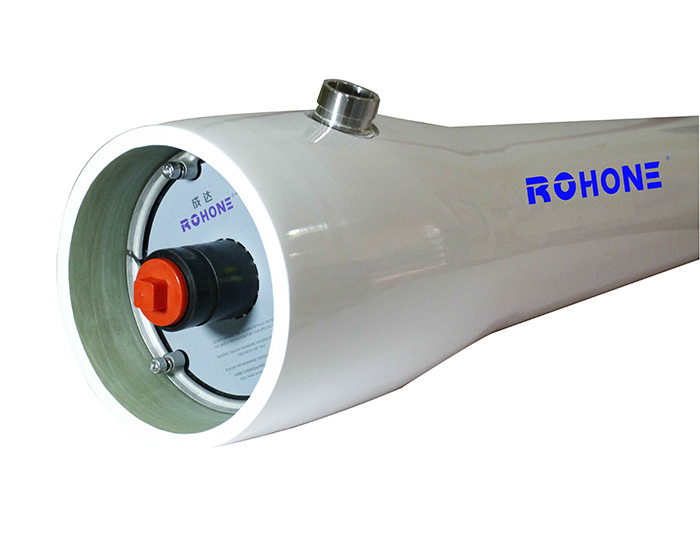Commonly used processes for liquid membrane filtration are: mechanical filtration, traditional filtration, micro-method, ultrafiltration, nanofiltration, reverse osmosis, electrodialysis, etc., their separation accuracy is also different, the filtration accuracy of reverse osmosis is the highest. Remove almost all impurities in water, such as ions, organics, microorganisms, etc., but the corresponding operating pressure range is relatively high, generally between 100 ~ 1000psi. Other common filtration processes generally have the law that the operating pressure decreases with the decrease in filtration accuracy. FRP pressure vessel supplier to share with you:
Membrane separation filtration process:
Cross-flow filtration: Cross-flow filtration refers to a type of filtration where the flow direction of the filtrate is different from the direction of water production. The raw water flows from the left along the horizontal direction, and the concentrated water flows out from the right. However, the water flow direction of the permeated aquatic product has a certain angle with the direction of the raw water. This type of filtration is not caused by the inflow / concentrated water and produced water. Cross-flow filtering. Common cross-flow filtration: reverse osmosis, nanofiltration, partial ultrafiltration, dialysis, etc .;
The biggest advantage of cross-flow filtration is that it has good anti-pollution performance, because most of the impurities trapped by the filter membrane are taken away by concentrated water, and only a small amount of impurities are trapped on the membrane surface. At the same time, the water continuously flushes the membrane surface, ensuring the filtration membrane performance Long-term stable operation. The biggest disadvantage of cross-flow filtration is that there is waste water discharge. Because cross-flow filtration requires concentrated water to carry out impurities, condensed water must be generated, resulting in waste water discharge. Cross-flow filtration must produce wastewater. Due to the structural characteristics of the filtration membrane used for cross-flow filtration, once the wastewater discharge is stopped, a large amount of impurities will be deposited on the membrane surface, making reverse osmosis membrane pressure vessels. It is covered by impurities in a very short time and loses its filtering ability.

Reverse Osmosis Membrane Pressure Vessels
Full Filtration: Full filtration refers to a filtering process in which the filtering fluid passes through the filtering medium. When the filtering fluid passes through the filtering medium, the impurities or part of the impurities contained in the filtering fluid are trapped on the surface of the filtering medium or adsorbed or converted into other substances, thereby This allows the filtrate to be purified.
Full-scale filtration is the most common filter with a wide range of applications, such as traditional mechanical filters, quartz sand filters, activated carbon filters, manganese sand filters, ion exchange filters, microfiltration, ultra German, bag filters And so on.
The advantages of full volume filtration are: large filtration volume, low support, and almost no waste water discharge.
The disadvantage of full-scale filtration is that the filtration accuracy is low, and generally ionic impurities cannot be filtered. The filter media is easily contaminated and needs to be regularly cleaned or even replaced.
Principle of osmosis and reverse osmosis: As early as the 17th century, people had discovered the phenomenon of osmosis. At that time, people found that if the pig's bladder was filled with distilled water and then soaked in saline, the distilled water in the water would slowly penetrate the pig's bladder into In human brine, the salt concentration in the brine will also decrease. This kind of solvent permeates through the semi-permeable membrane from the lower side of the solute concentration to the higher-concentration side, which is the phenomenon of permeation. If this experiment is performed with salt solution and water, water molecules will pass through the semi-permeable membrane from the low TDS One side penetrates to the high TDS side. The reverse osmosis phenomenon refers to the penetration of a solvent through a semi-permeable membrane from the side with a high concentration of solutes to the side with a low concentration, that is, the water molecules permeate from the side with high TDS to the side with low IDS, which is equivalent to from saline water. Get fresh water. The occurrence of reverse osmosis requires two conditions, external energy input and a suitable semi-permeable membrane.
The reverse osmosis phenomenon cannot occur without any external energy input, and can only occur when a certain amount of pressure is applied from the outside.
From the mass transfer mechanism and model of reverse osmosis, there are several theories:
1. Phenomenological model
2. Dissolve one-to-one diffusion model
3.Preferential adsorption of a capillary flow model
4, hydrogen bonding theory
None of these theories can perfectly explain the principle of reverse osmosis. Although people have not revealed the essence of reverse osmosis, it does not prevent people from using the reverse osmosis phenomenon to develop a high performance reverse osmosis membrane. blessing.